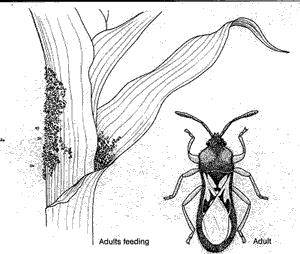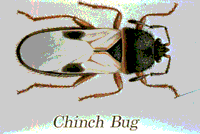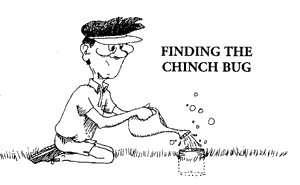 |
Symptoms
Chinch bugs do their worst damage in the heat of the summer in August and early September. Suspect chinch bugs when you see large, distinct, circular patches, primarily in the sunny areas of your lawn, that turn yellow, then brown, and then die. These patches often first appear near sidewalks, driveways, streets, and other borders such as railroad ties or flagstones which reflect heat onto the lawn. The yellowish spots eventually spread outward into the rest of the lawn, showing the greatest damage at their centers where the chinch bugs congregate. They also seek shelter under exterior siding and in cracks and crevices of houses.
 |
Research shows that in lawns in good condition 10 to 15 chinch bugs per square foot will not cause any problems. They are kept in check by their natural enemies, including ants and ground spiders. However, in lawns stressed by compacted soil, drought or heavy thatch, even a few chinch bugs will do damage because the grass plants are weakened by these conditions and chinch bug predator populations are low.
Discovering Chinch Bugs
Inspect and Sniff: In spring, check 4 or 5 different spots in the lawn. Spread the grass blades apart with your hands and look for small black or red bugs with white markings scurrying around the soil surface near plant crowns. Notice the smell. Chinch bugs produce an offensive odor that advertises their presence, especially when populations are high and when they have been crushed by foot traffic.
 |
Flotation Trick: If you suspect chinch bugs, flush them from cover. Cut the top and bottom from a 2 pound coffee can, push it a few inches into the soil under yellowed turf. Fill it with warm water. If present, chinch bugs at all stages will float to the surface within 3 to 5 minutes. Add more water, if needed, to keep its level above the grass surface during the test period. Repeat this process in 3 or 4 other suspicious areas. Although time consuming, flotation sampling accurately confirms chinch bug infestations, also revealing their extent and density.
Cloth Trapping: In late spring mark off 2 or 3 lawn sections 2 feet square--some showing damage, others seeming healthy. Mix 2 tablespoons liquid detergent or insecticidal soap concentrate per gallon of water and saturate each area evenly with a sprinkling can. Then lay a piece of white cloth such as flannel or garden fleece over each area. After about 15 to 20 minutes, check the underside of the cloth for chinch bugs fleeing the irritating soap.

